A Green Approach to 2-Substituted Benzo- and Naphthothiazoles via N-bromosuccinimide/Bromide-Mediated C(aryl)-S Bond Formation
Abstract
1. Introduction
2. Results and Discussion
3. Materials and Methods
3.1. General Information
3.2. General Procedures for Preparation of Substrates
3.2.1. Method for Preparation of Phenylthioureas
3.2.2. Method for Preparation of Thiobenzanilides
3.3. General Procedures for Preparation of Benzothiazoles
3.3.1. Intramolecular Cyclization of Phenylthioureas and Thiobenzanilides (Method E)
3.3.2. One-Pot Synthesis Using Anilines and Ammonium Thiocyanate (Method F)
Using DME as Solvent
Using Glacial Acetic Acid as Solvent
3.3.3. One-Pot Synthesis Using Isothiocyanate and Amines (Method G)
4. Conclusions
Supplementary Materials
Author Contributions
Funding
Acknowledgments
Conflicts of Interest
References
- Herrera Cano, N.; Ballari, M.; López, A.; Santiago, A. New synthesis and biological evaluation of benzothiazole derivates as antifungal agents. J. Agric. Food Chem. 2015, 63, 3681–3686. [Google Scholar] [CrossRef] [PubMed]
- Kok, S.; Gambari, R.; Chui, C.; Yuen, M.; Lin, E.; Wong, R.; Lau, F.; Cheng, G.; Lam, W.; Chan, S. Synthesis and anti-cancer activity of benzothiazole containing phthalimide on human carcinoma cell lines. Bioorg. Med. Chem. 2008, 16, 3626–3631. [Google Scholar] [CrossRef] [PubMed]
- Singh, M.; Tilak, R.; Nath, G.; Awasthi, S.; Agarwal, A. Design, synthesis and antimicrobial activity of novel benzothiazole analogs. Eur. J. Med. Chem. 2013, 63, 635–644. [Google Scholar] [CrossRef] [PubMed]
- Massari, S.; Daelemans, D.; Barreca, M.L.; Knezevich, A.; Sabatini, S.; Cecchetti, V.; Marcello, A.; Pannecouque, C.; Tabarrini, O. A 1, 8-naphthyridone derivative targets the HIV-1 Tat-mediated transcription and potently inhibits the HIV-1 replication. J. Med. Chem. 2010, 53, 641–648. [Google Scholar] [CrossRef] [PubMed]
- Jimonet, P.; Audiau, F.; Barreau, M.; Blanchard, J.-C.; Boireau, A.; Bour, Y.; Coleno, M.-A.; Doble, A.; Doerflinger, G.; Huu, C.; et al. Riluzole series. Synthesis and in vivo “antiglutamate” activity of 6-substituted-2-benzothiazolamines and 3-substituted-2-imino-benzothiazolines. J. Med. Chem. 1999, 42, 2828–2843. [Google Scholar] [CrossRef]
- Wang, X.; Sarris, K.; Kage, K.; Zhang, D.; Brown, S.; Kolasa, T.; Surowy, C.; El Kouhen, O.; Muchmore, S.; Brioni, J.; et al. Synthesis and evaluation of benzothiazole-based analogues as novel, potent, and selective fatty acid amide hydrolase inhibitors. J. Med. Chem. 2009, 52, 170–180. [Google Scholar] [CrossRef]
- Mathis, C.; Wang, Y.; Holt, D.; Huang, G.; Debnath, M.; Klunk, W. Synthesis and evaluation of 11C-labeled 6-substituted 2-arylbenzothiazoles as amyloid imaging agents. J. Med. Chem. 2003, 46, 2740–2754. [Google Scholar] [CrossRef]
- Hrobáriková, V.; Hrobárik, P.; Gajdoš, P.; Fitilis, I.; Fakis, M.; Persephonis, P.; Zahradník, P. Benzothiazole-based fluorophores of donor− π-acceptor− π-donor type displaying high two-photon absorption. J. Org. Chem. 2010, 75, 3053–3068. [Google Scholar] [CrossRef]
- Prajapati, N.; Vekariya, R.; Borad, M.; Patel, H. Recent advances in the synthesis of 2-substituted benzothiazoles: A review. RSC Adv. 2014, 4, 60176–60208. [Google Scholar] [CrossRef]
- Sun, Y.; Jiang, H.; Wu, W.; Zeng, W.; Wu, X. Copper-catalyzed synthesis of substituted benzothiazoles via condensation of 2-aminobenzenethiols with nitriles. Org. Lett. 2013, 15, 1598–1601. [Google Scholar] [CrossRef]
- Deng, H.; Li, Z.; Ke, F.; Zhou, X. Cu-Catalyzed Three-Component Synthesis of Substituted Benzothiazoles in Water. Chem. Eur. J. 2012, 18, 4840–4843. [Google Scholar] [CrossRef] [PubMed]
- Xu, Y.; Li, B.; Zhang, X.; Fan, X. Metal-free synthesis of 2-aminobenzothiazoles via iodine-catalyzed and oxygen-promoted cascade reactions of isothiocyanatobenzenes with amines. J. Org. Chem. 2017, 82, 9637–9646. [Google Scholar] [CrossRef] [PubMed]
- Ding, Q.; He, X.; Wu, J. Synthesis of 2-aminobenzothiazole via copper (I)-catalyzed Tandem Reaction of 2-iodobenzenamine with isothiocyanate. J. Comb. Chem. 2009, 11, 587–591. [Google Scholar] [CrossRef] [PubMed]
- Inamoto, K.; Hasegawa, C.; Kawasaki, J.; Hiroya, K.; Doia, T. Use of Molecular Oxygen as a Reoxidant in the Synthesis of 2-Substituted Benzothiazoles via Palladium-Catalyzed C- H Functionalization/Intramolecular C-S Bond Formation. Adv. Synth. Catal. 2010, 352, 2643–2655. [Google Scholar] [CrossRef]
- Feng, E.; Huang, H.; Zhou, Y.; Ye, D.; Jiang, H.; Liu, H. Metal-Free Synthesis of 2-Substituted (N, O, C) Benzothiazoles via an Intramolecular C−S Bond Formation. J. Comb. Chem. 2010, 12, 422–429. [Google Scholar] [CrossRef]
- Sharma, S.; Pathare, R.; Maurya, A.; Gopal, K.; Kanchan Roy, T.; Sawant, D.; Pardasani, R. Ruthenium catalyzed intramolecular C–S coupling reactions: Synthetic scope and mechanistic insight. Org. Lett. 2016, 18, 356–359. [Google Scholar] [CrossRef]
- Wang, H.; Wang, L.; Shang, J.; Li, X.; Wang, H.; Gui, J.; Lei, A. Fe-catalysed oxidative C–H functionalization/C–S bond formation. Chem. Commun. 2012, 48, 76–78. [Google Scholar] [CrossRef]
- Zhao, J.; Huang, H.; Wu, W.; Chen, H.; Jiang, H. Metal-free synthesis of 2-aminobenzothiazoles via aerobic oxidative cyclization/dehydrogenation of cyclohexanones and thioureas. Org. Lett. 2013, 15, 2604–2607. [Google Scholar] [CrossRef]
- Zhu, Y.; Zhang, R.; Sang, W.; Wang, H.; Wu, Y.; Yu, B.; Zhang, J.; Cheng, H.; Chen, C. Ligand-controlled palladium catalysis enables switch between mono-and di-arylation of primary aromatic amines with 2-halobenzothiazoles. Org. Chem. Front. 2020, 7, 1981–1990. [Google Scholar] [CrossRef]
- Cheng, H.; Zhu, Y.Q.; Liu, P.F.; Yang, K.Q.; Yan, J.; Sang, W.; Tang, X.S.; Zhang, R.; Chen, C. Switchable and Scalable Heteroarylation of Primary Amines with 2-Chlorobenzothiazoles under Transition-Metal-Free and Solvent-Free Conditions. J. Org. Chem. 2021, 86, 10288–10302. [Google Scholar] [CrossRef]
- Liu, X.; Dong, Z.B. A Review on Domino Condensation/Cyclization Reactions for the Synthesis of 2-Substituted 1, 3-Benzothiazole Derivatives. Eur. J. Org. Chem. 2020, 4, 408–419. [Google Scholar] [CrossRef]
- García-Báez, E.V.; Padilla-Martínez, I.I.; Tamay-Cach, F.; Cruz, A. Benzothiazoles from condensation of o-aminothiophenoles with carboxylic acids and their derivatives: A review. Molecules 2021, 26, 6518. [Google Scholar] [CrossRef] [PubMed]
- Zhilitskaya, L.V.; Shainyan, B.A.; Yarosh, N.O. Modern approaches to the synthesis and transformations of practically valuable benzothiazole derivatives. Molecules 2021, 26, 2190. [Google Scholar] [CrossRef] [PubMed]
- Shainyan, B.A.; Zhilitskaya, L.V.; Yarosh, N.O. Synthetic Approaches to Biologically Active C-2-Substituted Benzothiazoles. Molecules 2022, 27, 2598. [Google Scholar] [CrossRef] [PubMed]
- Gan, F.; Luo, P.; Lin, J.; Ding, Q. Recent Advances in the Synthesis and Applications of 2-Arylbenzothiazoles. Synthesis 2020, 52, 3530–3548. [Google Scholar] [CrossRef]
- Koval, I.V. N-halo reagents. N-halosuccinimides in organic synthesis and in chemistry of natural compounds. Russ. J. Org. Chem. 2002, 38, 301–337. [Google Scholar] [CrossRef]
- Downer-Riley, N.; Jackson, Y. Iodine-mediated cyclisation of thiobenzamides to produce benzothiazoles and benzoxazoles. Tetrahedron 2007, 63, 10276–10281. [Google Scholar] [CrossRef]
- Jordan, A.; Luo, C.; Reitz, A.B. Efficient conversion of substituted aryl thioureas to 2-aminobenzothiazoles using benzyltrimethylammonium tribromide. J. Org. Chem. 2003, 68, 8693–8696. [Google Scholar] [CrossRef]
- Bose, D.; Idrees, M. Hypervalent iodine mediated intramolecular cyclization of thioformanilides: Expeditious approach to 2-substituted benzothiazoles. J. Org. Chem. 2006, 71, 8261–8263. [Google Scholar] [CrossRef]
- Downer-Riley, N.; Jackson, Y. Conversion of thiobenzamides to benzothiazoles via intramolecular cyclization of the aryl radical cation. Tetrahedron 2008, 64, 7741–7744. [Google Scholar] [CrossRef]
- Giles, M.; Thomson, C.; Eyley, S.; Cole, A.; Goodwin, C.; Hurved, P.; Morlin, A.; Tornos, J.; Atkinson, S.; Just, C.; et al. Development of a manufacturing process for sibenadet hydrochloride, the active ingredient of Viozan. Org. Process. Res. Dev. 2004, 8, 628–642. [Google Scholar] [CrossRef]
- Ganin, J.; Melendez, E.; Merchan, F.; Merino, P.; Orduna, J.; Tejero, T. Chemoselectivity in the oxidation of unsymmetrical Thioureas with NBS/sulfuric acid: Benzothiazoles vs. 1, 2, 4-Thiadiazoles. Synth. Commun. 1990, 20, 2327–2334. [Google Scholar] [CrossRef]
- Moghaddam, F.; Zargarani, D. An efficient one-step cyclization of thiobenzanilides to benzothiazoles: Using N-bromosuccinimide under mild conditions. J. Sulfur. Chem. 2009, 30, 507–512. [Google Scholar] [CrossRef]
- Jichkar, A.; Opai, I.; Karade, N. N-Iodosuccinimide mediated intramolecular oxidative C (sp 2)-S bond formation for the synthesis of 2-aminobenzothiazole derivatives. J. Sulfur. Chem. 2022, 43, 144–155. [Google Scholar] [CrossRef]
- Chakrabarty, M.; Kundu, T.; Arima, S.; Harigay, Y. An expedient, regioselective synthesis of 2-alkylamino-and 2-alkylthiothiazolo [5, 4-e] indoles. Tetrahedron Lett. 2005, 46, 2865–2868. [Google Scholar] [CrossRef]
- Barrett, O.; Downer-Riley, N.; Jackson, Y. Synthesis of some novel benzobisthiazoles. Heterocycles 2010, 81, 1641–1649. [Google Scholar] [CrossRef]
- Shao, L.; Shi, M. N-bromosuccinimide and lithium bromide: An efficient combination for the dibromination of carbon-carbon unsaturated bonds. Synlett 2006, 08, 1269–1271. [Google Scholar] [CrossRef]
- Yella, R.; Murru, S.; Ali, A.; Patel, B. Arylthioureas with bromine or its equivalents gives no ‘Hugerschoff’reaction product. Org. Biomol. Chem. 2010, 8, 3389–3393. [Google Scholar] [CrossRef]
- Kumbhare, R.M.; Dadmal, T.; Kosurkar, U.; Sridhar, V.; Rao, J.V. Synthesis and cytotoxic evaluation of thiourea and N-bis-benzothiazole derivatives: A novel class of cytotoxic agents. Bioorg. Med. Chem. Lett. 2012, 22, 453–455. [Google Scholar] [CrossRef]
- Aitken, L.; Benek, O.; McKelvie, B.E.; Hughes, R.E.; Hroch, L.; Schmidt, M.; Major, L.L.; Vinklarova, L.; Kuca, K.; Smith, T.K.; et al. Novel benzothiazole-based ureas as 17β-HSD10 inhibitors, a potential alzheimer’s disease treatment. Molecules 2019, 24, 2757. [Google Scholar] [CrossRef]
- Deprez, P.; Temal, T.; Jary, H.; Auberval, M.; Lively, S.; Guédin, D.; Vevert, J.-P. New potent calcimimetics: II. Discovery of benzothiazole trisubstituted ureas. Bioorg. Med. Chem. Lett. 2013, 23, 2455–2459. [Google Scholar] [CrossRef] [PubMed]
- Shim, H.; Brown, B.M.; Singh, L.; Singh, V.; Fettinger, J.C.; Yarov-Yarovoy, V.; Wulff, H. The trials and tribulations of structure assisted design of KCa channel activators. Front. Pharmacol. 2019, 10, 972. [Google Scholar] [CrossRef] [PubMed]
- He, Y.; Li, J.; Luo, S.; Huang, J.; Zhu, Q. A metal-free synthesis of 2-aminobenzothiazoles through aminyl radical addition to aryl isothiocyanates. Chem. Commun. 2016, 52, 8444–8447. [Google Scholar] [CrossRef] [PubMed]
- Frank, R.; Smith, P. α-Phenylthiourea. Org. Synth. 1948, 28, 89. [Google Scholar] [CrossRef]
- Pankova, A.; Samartsev, M.; Shulgin, I.; Golubev, P.; Avdontceva, M.; Kuznetsov, M. Synthesis of thiazolidines via regioselective addition of unsymmetric thioureas to maleic acid derivatives. RSC Adv. 2014, 4, 51780–51786. [Google Scholar] [CrossRef]
- Resch, S.; Schneider, A.; Beichler, R.; Spera, M.; Fanous, J.; Schollmeyer, D.; Waldvogel, S. Naphthyridine Derivatives as a Model System for Potential Lithium–Sulfur Energy-Storage Applications. Eur. J. Org. Chem. 2015, 2015, 933–937. [Google Scholar] [CrossRef]
- Zubruyev, O.; Stiasni, N.; Kappe, C. Preparation of Thioamide Building Blocks via Microwave-Promoted Three-Component Kindler Reactions. J. Comb. Chem. 2003, 5, 145–148. [Google Scholar] [CrossRef] [PubMed]
- Xu, H.; Deng, H.; Li, Z.; Xiang, H.; Zhou, X. Synthesis of Thioamides by Catalyst-Free Three-Component Reactions in Water. Eur. J. Org. Chem. 2013, 2013, 7054–7057. [Google Scholar] [CrossRef]
- Katritzky, A.R.; Kirichenko, N.; Rogovoy, B.V.; Kister, J.; Tao, H. Synthesis of Mono- and N,N-Disubstituted Thioureas and N-Acylthioureas. Synthesis 2004, 11, 1799–1805. [Google Scholar] [CrossRef]
- Grosjean, S.; Triki, S.; Meslin, J.-C.; Julienne, K.; Deniaud, D. Synthesis of Nitrogen Bicyclic Scaffolds: Pyrimido [1,2-a]Pyrimidine-2,6-Diones. Tetrahedron 2010, 66, 9912–9924. [Google Scholar] [CrossRef]
- Hay, M.P.; Turcotte, S.; Flanagan, J.U.; Bonnet, M.; Chan, D.A.; Sutphin, P.D.; Nguyen, P.; Giaccia, A.J.; Denny, W.A. 4-Pyridylanilinothiazoles That Selectively Target von Hippel−Lindau Deficient Renal Cell Carcinoma Cells by Inducing Autophagic Cell Death. J. Med. Chem. 2010, 53, 787–797. [Google Scholar] [CrossRef]
- Diwakar, K.; Sonar, P.K.; Mishra, M.; Tripathi, A.C.; Saraf, S.K. Facile Synthesis, Molecular Docking and Toxicity Studies of 4-Phenyl-3-Phenylamino-4H-[1,2,4]Thiadiazol-5-One Analogs as GABAA Receptor Agonists. Med. Chem. Res. 2016, 25, 2631–2642. [Google Scholar] [CrossRef]
- Cheung, C.W.; Surry, D.S.; Buchwald, S.L. Mild and Highly Selective Palladium-Catalyzed Monoarylation of Ammonia Enabled by the Use of Bulky Biarylphosphine Ligands and Palladacycle Precatalysts. Org. Lett. 2013, 15, 3734–3737. [Google Scholar] [CrossRef]
- Jiang, H.; Yu, W.; Tang, X.; Li, J.; Wu, W. Copper-Catalyzed Aerobic Oxidative Regioselective Thiocyanation of Aromatics and Heteroaromatics. J. Org. Chem. 2017, 82, 9312–9320. [Google Scholar] [CrossRef] [PubMed]
- Ding, Q.; Cao, B.; Liu, X.; Zong, Z.; Peng, Y.-Y. Synthesis of 2-Aminobenzothiazole via FeCl3-Catalyzed Tandem Reaction of 2-Iodoaniline with Isothiocyanate in Water. Green Chem. 2010, 12, 1607–1610. [Google Scholar] [CrossRef]
- Cano, R.; Ramón, D.J.; Yus, M. Transition-Metal-Free O-, S-, and N-Arylation of Alcohols, Thiols, Amides, Amines, and Related Heterocycles. J. Org. Chem. 2011, 76, 654–660. [Google Scholar] [CrossRef] [PubMed]
- Zhao, N.; Liu, L.; Wang, F.; Li, J.; Zhang, W. Copper/N,N,N′,N′-Tetramethylethylenediamine-Catalyzed Synthesis of N-Substituted Benzoheterocycles via C-S Cross- Coupling at Ambient Temperature in Water. Adv. Synth. Catal. 2014, 356, 2575–2579. [Google Scholar] [CrossRef]
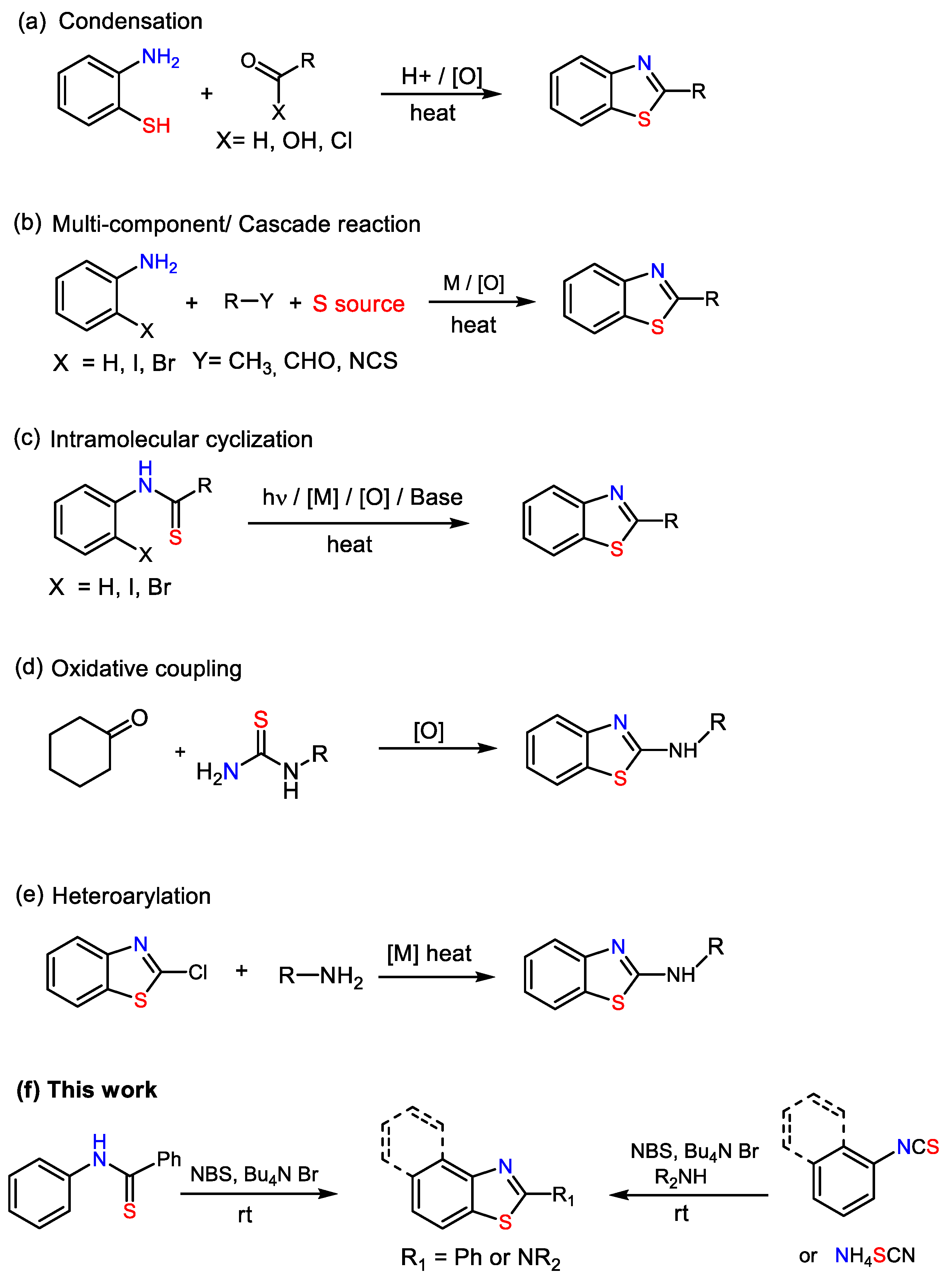
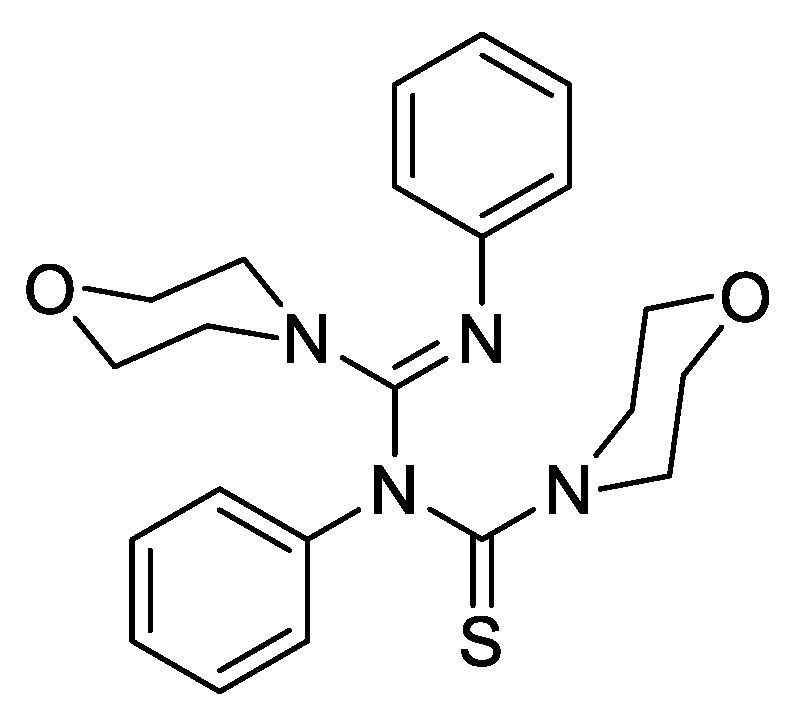
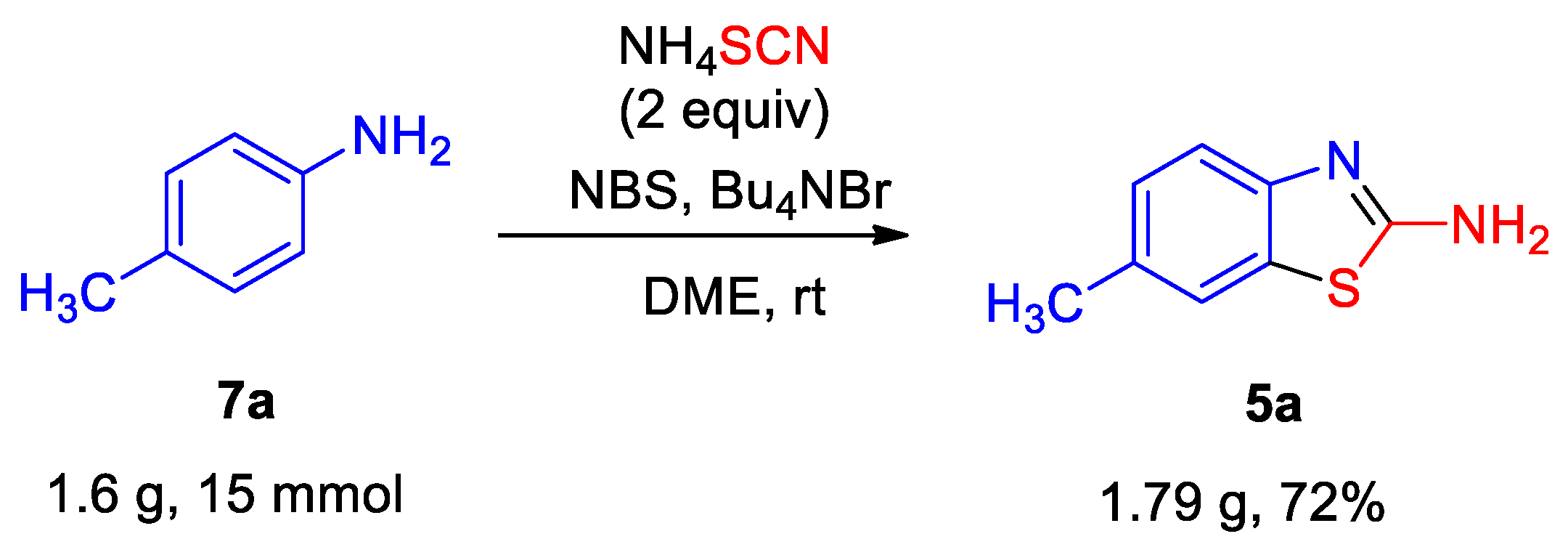
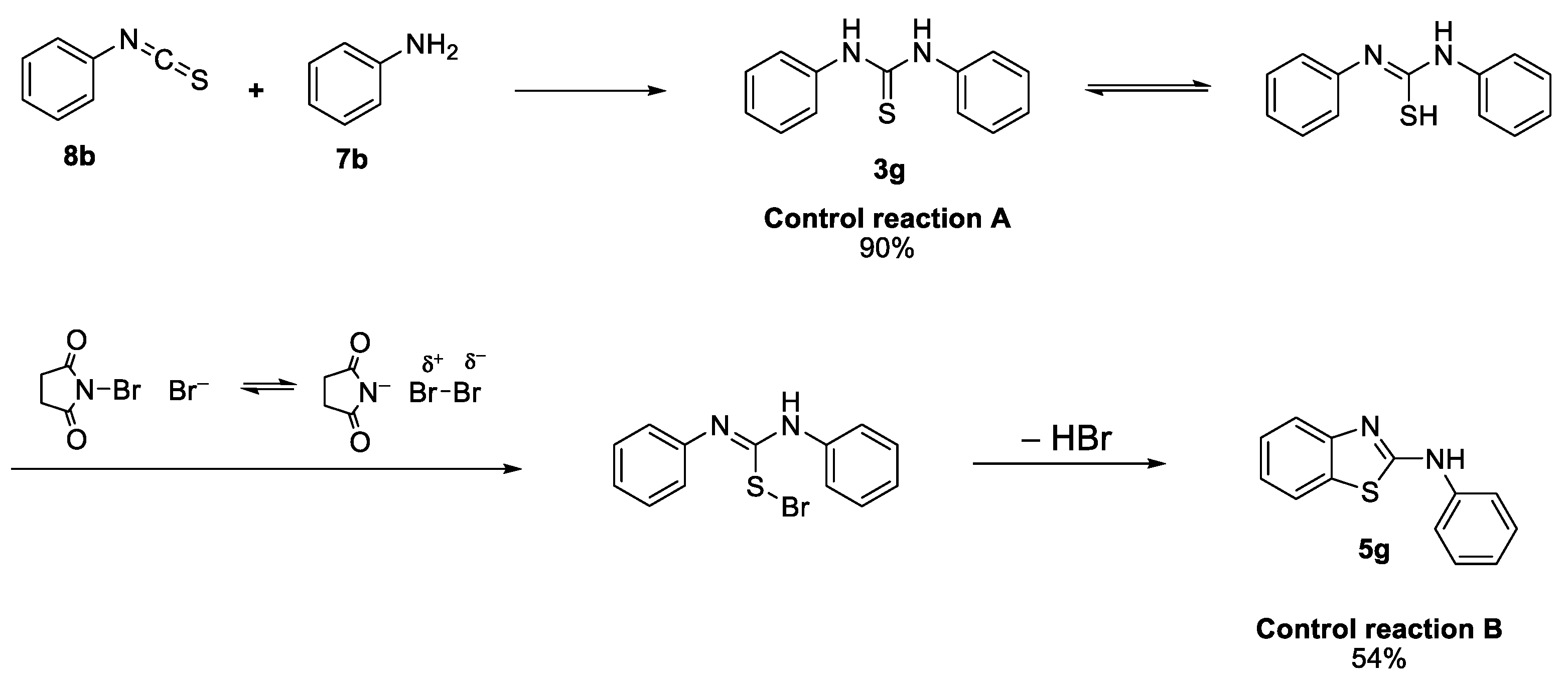
 | ||||
|---|---|---|---|---|
| Entry | NXS | [X−] | Solvent | Yield (%) b |
| 1 | NBS | − | CH2Cl2: CCl4 | 48 |
| 2 | NBS | − | TFT | 20 |
| 3 | NBS | − | TFE | 40 |
| 4 | NBS | − | DME | 40, (36 c) d |
| 5 | NBS | − | AcOH | 23, (12 c) d |
| 6 | NBS | − | MeCN | 3, (− c) |
| 7 | NBS | − | MeOH | 16, (− c) |
| 8 | NBS | − | EtOH | 19, (6 c) |
| 9 | NBS | − | water | 4, (− c) |
| 10 | NBS | − | DMSO | 7 |
| 11 | NCS | − | DME | 33 |
| 12 | NIS | − | DME | 40 |
| 13 | NBS | Bu4NBr | DME | 60 e |
| 14 | NBS | Bu4NBr | AcOH | 46 e |
| 15 | NCS | Me4NCl | DME | 27 e |
| 16 | NIS | Bu4NI | DME | − e,f |
| 17 | NBS | HBr | DME | 17 e |
| 18 | NBS | LiBr | DME | 55 e |
| 19 | NBS | Bu4NBr | EtOH | 28 e |
 |
 |
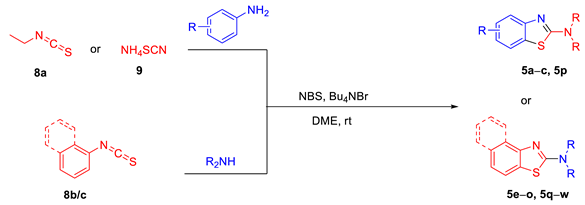 |
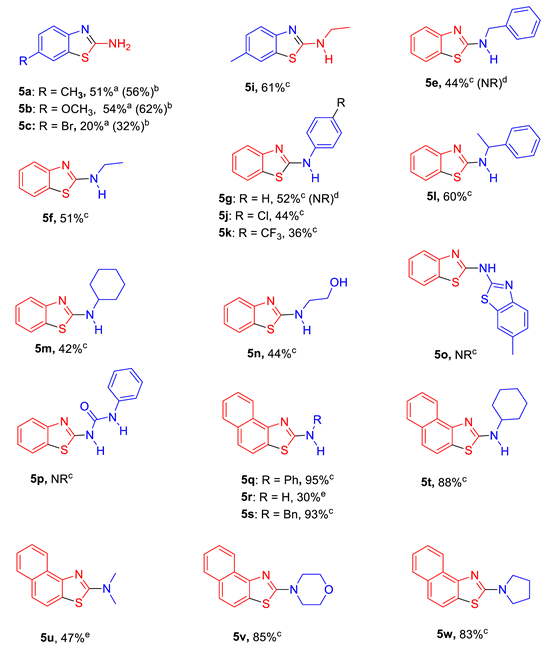 |
 | ||||
|---|---|---|---|---|
| Compound | R1 | R2 | M.P. (°C) | M.P. (°C) [Lit] |
| 2 | H | H | 124–126 | 128–129 [53] |
| 5a | 6-CH3 | H | 125–127 | 129–130 [54] |
| 5b | 6-OCH3 | H | 163–165 | 158–156 [54] |
| 5c | 4-Br | H | 199–200 | 215–217 [28] |
| 5e | H | CH2Ph | 161–162 | 160–161 [14] |
| 5f | H | Et | 94–95 | 114–116 [55] |
| 5g | H | Ph | 147–149 | 159–160 [56] |
| 5i | 6-CH3 | Et | Viscous oil | 104–106 [55] |
| 5j | H | 4-Cl-Ph | 189–191 | 207–208 [57] |
| 5k | H | 4-CF3-Ph | 173–175 | 194–196 [57] |
| 5l | H | CH(CH3)Ph | Tan wax | 131–132 [14] |
| 5m | H | cyclohexyl | Viscous oil | 78–80 [57] |
| 5n | H | CH2CH2OH | 97–99 | 99–101 [28] |
 | ||||
| Compound | R1 | R2 | M.P. (°C) | M.P. (°C) [Lit] |
| 5q | H | Ph | 139–141 | 140–141 [42] |
| 5r | H | H | 188–191 | 190–192 [18] |
| 5s | H | Bn | 107–109 | 104–106 [18] |
| 5t | H | cyclohexyl | light brown viscous oil | 115–116 [42] |
| 5u | CH3 | CH3 | 116–118 | 115–117 [43] |
| 5v | -(CH2)2-O-(CH2)2- | 188–190 | 183–184 [38] | |
| 5w | -(CH2)4- | 125–127 | 143–145 [38] | |
 | ||||
| Compound | R | M.P. (°C) | M.P. (°C) [Lit] | |
| 6b | 6-CH3 | 120–122 | 118–119 [30] | |
| 6c | 6-OCH3 | 113–115 | 114–116 [30] | |
| 6d | 4-OCH3 | 100–103 | 99–100 [27] | |
| 6e | 4,7-OCH3 | 119–121 | 122–124 [30] | |
| 6f | 5-OCH3 | 74–76 | 75–77 [30] | |
Publisher’s Note: MDPI stays neutral with regard to jurisdictional claims in published maps and institutional affiliations. |
© 2022 by the authors. Licensee MDPI, Basel, Switzerland. This article is an open access article distributed under the terms and conditions of the Creative Commons Attribution (CC BY) license (https://creativecommons.org/licenses/by/4.0/).
Share and Cite
Brown, A.T.; Downer-Riley, N.K. A Green Approach to 2-Substituted Benzo- and Naphthothiazoles via N-bromosuccinimide/Bromide-Mediated C(aryl)-S Bond Formation. Molecules 2022, 27, 7876. https://doi.org/10.3390/molecules27227876
Brown AT, Downer-Riley NK. A Green Approach to 2-Substituted Benzo- and Naphthothiazoles via N-bromosuccinimide/Bromide-Mediated C(aryl)-S Bond Formation. Molecules. 2022; 27(22):7876. https://doi.org/10.3390/molecules27227876
Chicago/Turabian StyleBrown, Ainka T., and Nadale K. Downer-Riley. 2022. "A Green Approach to 2-Substituted Benzo- and Naphthothiazoles via N-bromosuccinimide/Bromide-Mediated C(aryl)-S Bond Formation" Molecules 27, no. 22: 7876. https://doi.org/10.3390/molecules27227876
APA StyleBrown, A. T., & Downer-Riley, N. K. (2022). A Green Approach to 2-Substituted Benzo- and Naphthothiazoles via N-bromosuccinimide/Bromide-Mediated C(aryl)-S Bond Formation. Molecules, 27(22), 7876. https://doi.org/10.3390/molecules27227876






